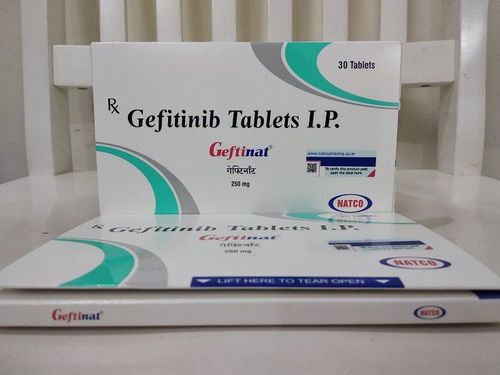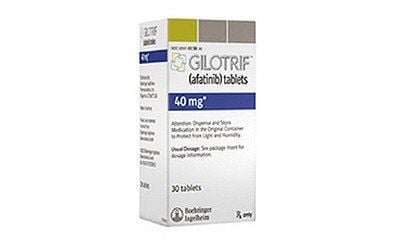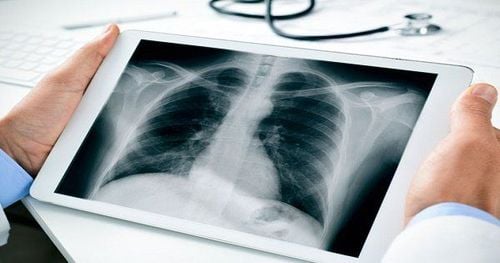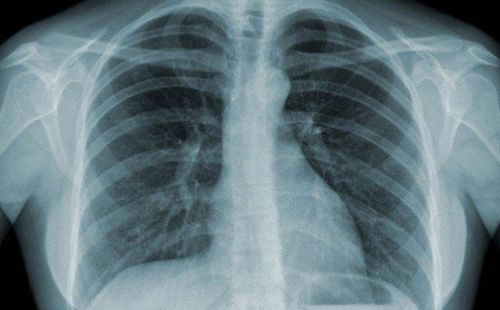This is an automatically translated article.
Post by Master, Doctor Ha Thi Thu Hien - Pathologist - Laboratory Department - Vinmec Times City International Hospital
Usually the signs of lung cancer do not appear until the disease is in an advanced stage. Even when lung cancer causes symptoms, many people can mistake them for other problems, such as an infection or long-term effects from smoking. Therefore, screening will help reduce the risk of dying from lung cancer.
1. Can lung cancer be detected early?
Lung cancer screening is the use of tests or examinations to find the disease in people with the disease who have no symptoms. Routine chest X-rays have been studied to screen for lung cancer, but this method is difficult to detect early.
Instead, a test called low-dose computed tomography (LDCT or CT scan) has been studied in people at higher risk for lung cancer. Low-dose CT scans of the chest can help find abnormal areas in the lungs.
Research has shown that using CT scans to screen people at high risk for lung cancer saves more lives than chest X-rays. For people at high risk, having a CT scan every year before symptoms start reduces the risk of dying from lung cancer.
Trắc nghiệm: Hiểu về phổi của bạn
Phổi là một tạng lớn rất quan trọng và không thể thiếu trong cơ thể. Việc giữ cho lá phổi của bạn luôn khỏe mạnh, tránh khỏi những bệnh phổ biến về phổi là điều bạn cần lưu ý để giúp cơ thể bạn có thể vận hành tốt. Hãy cùng chúng tôi trả lời nhanh những câu hỏi trắc nghiệm sau sẽ giúp bạn hiểu về phổi của bạn hơn.
Bài dịch từ: webmd.com
The following content is prepared under supervision of Thạc sĩ, Bác sĩ y khoa, Nguyễn Huy Nhật , Nội Hô hấp , Khoa Khám bệnh & Nội khoa - Bệnh viện Đa khoa Quốc tế Vinmec Đà Nẵng
2. Screening for early detection of lung cancer
Lung cancer is a common cancer in both men and women. It is also the leading cause of death from cancer. If lung cancer is found at an earlier stage, when the tumor is small and before it has spread, it is more likely to be successfully treated.
Usually signs of lung cancer do not appear until the disease is in a more advanced stage. Even when lung cancer causes symptoms, many people can mistake them for other problems, such as an infection or long-term effects from smoking. This can delay diagnosis. People who smoke and have a history of smoking have a higher risk of developing lung cancer.
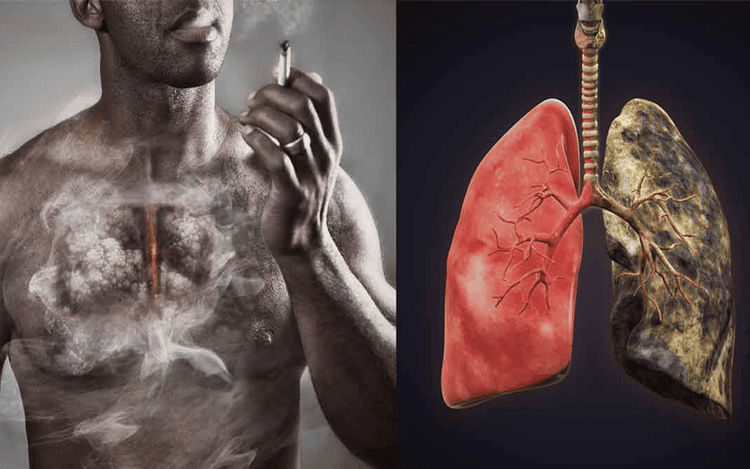
3. American Cancer Society Guidelines for Lung Cancer Screening
The American Cancer Society (ACS) has guidelines for lung cancer screening for everyone at higher risk of lung cancer based on the National Lung Screening Program. The ACS recommends annual lung cancer screening with a CT scan for people 55 to 74 years old, in good health, and who meet the following conditions:
Are current smokers or those who have quit drugs for the past 15 years. Have a smoking history of at least 30 packs of cigarettes per year. (years smoked multiplied by number of packs per day. For example, a person who smoked 2 packs a day for 15 years [2 x 15 = 30] has 30 packs of years to smoke. A person smokes 1 pack a day for 30 years.) years [1 x 30 = 30] also have 30 packs of years of smoking.) Get counseling to quit if they are smoking. Have been told by your doctor about the possible benefits, limitations, and harms of screening with a CT scan. Screened and treated for lung cancer.
4. Benefits of lung cancer screening
The main benefit of screening is in diagnosing lung cancer and reducing the risk of dying from the disease. However, with any screening method, not all people who are screened will have early detection of lung cancer.
Screening with CT scans will not be able to detect all lung cancers and not all cancers will be detected early.
Even if cancer is detected by screening, you can still die from lung cancer. Also, CT scans often detect noncancerous lesions, so further testing is needed to find out what they are. You may need more CT scans or more invasive tests such as a lung biopsy, where a piece of lung tissue is removed with a needle biopsy or during surgery. Each of these tests has its own risks.
If a person has a higher risk of lung cancer, the doctor can explain the risk factors and the American Cancer Society (ACS) cancer screening guidelines that apply to each person. Your doctor can also explain what happens during the screening and the best places to do the annual screening.
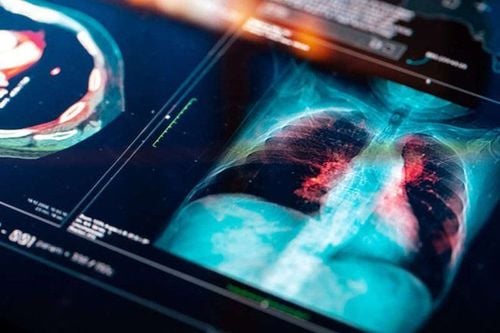
5. What to do if something abnormal is detected during the inspection?
Sometimes screening tests will show something abnormal in the lungs or nearby areas (possibly cancer). Most of these abnormal findings are usually not cancer, but CT scans or other tests are needed to be sure.
CT scans of the lungs can sometimes also incidentally show problems in other organs in the scan's field of view. Your doctor will discuss any findings with you if they are found.
6. National Lung Screening Trial
The National Lung Screening Trial is a large clinical trial looking at the use of CT scans of the chest to screen for lung cancer. Chest CT scans provide more detailed images than chest X-rays and are better at finding small abnormal areas in the lungs. Low-dose chest CT scans use a lower amount of radiation than standard chest CT scans and do not require the use of intravenous (IV) contrast.
The National Lung Screening Trial Program compares CT scans with chest X-rays in people at high risk for lung cancer to see if these scans can help reduce the risk of death lung cancer or not. The studies included more than 50,000 people aged 55 to 74 years who were current smokers or had a history of smoking and were in fairly good health. To be included in the study, they had to have a smoking history of at least 30 packs per year.
Former smokers could participate in the study if they had quit within the past 15 years. The studies did not include people who had a history of lung cancer or had symptoms or signs of lung cancer, had part of a lung removed, needed home oxygen, or had other serious medical problems. People in the study had three CT scans or three chest X-rays, one year apart, to look for abnormalities in the lungs that could be cancer.
After several years, research found that people who had CT scans had a 20% lower risk of dying from lung cancer than those who had chest X-rays. They were also 7% less likely to die (compared to any other cause) than those who had a chest X-ray.
Screening with CT scans also shows some disadvantages that need to be considered. A possible limitation of this test is that it sometimes also detects noncancerous abnormalities, but that may still need to be checked with other tests. As a result, some people may need additional tests such as other CT scans or even invasive tests such as a needle biopsy or partial lung surgery.
These additional tests rarely lead to serious complications, even in people who don't have lung cancer (or only have early-stage cancer).
When testing the national lung program also exposes people to small amounts of radiation during each test. It is less than the dose from a standard CT scan, but more than the dose from a chest X-ray. Some people who are screened may eventually need more CT scans, which means more exposure to radiation. When performed in tens of thousands of people, this radiation can be the cause of breast, lung or thyroid cancer in some people later on.
In a nutshell, lung cancer screening is the use of tests or examinations to find the disease in people with the disease who have no symptoms. Screening should only be done at facilities that have the appropriate type of CT scan machine and have experience in taking CT scans to screen for lung cancer. The screening facility should also have a team of specialists who can provide the patient with appropriate care and follow-up if there are abnormal results on the scan.
Currently, Vinmec International General Hospital has a Lung Cancer Screening Package with many outstanding advantages such as:
A team of highly qualified and experienced doctors. Comprehensive professional cooperation with domestic and international hospitals: Singapore, Japan, USA, .. Comprehensive treatment and care, multi-specialty coordination towards individualizing each patient. Having a full range of specialized facilities to diagnose the disease and stage it before treatment: Endoscopy, CT scan, PET-CT scan, MRI, histopathological diagnosis, gene-cell testing, .. Full range of main cancer treatment methods: surgery, radiation therapy, chemotherapy, stem cell transplant... When registering for the Lung Cancer Screening Package at Vinmec, customers will receive:
Examination respiratory specialist Low-dose computed tomography lung tumor screening.
Please dial HOTLINE for more information or register for an appointment HERE. Download MyVinmec app to make appointments faster and to manage your bookings easily.






